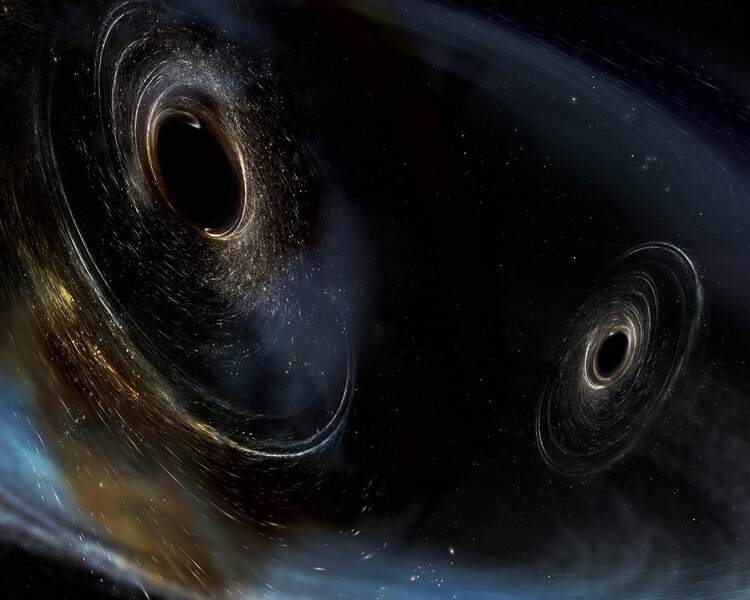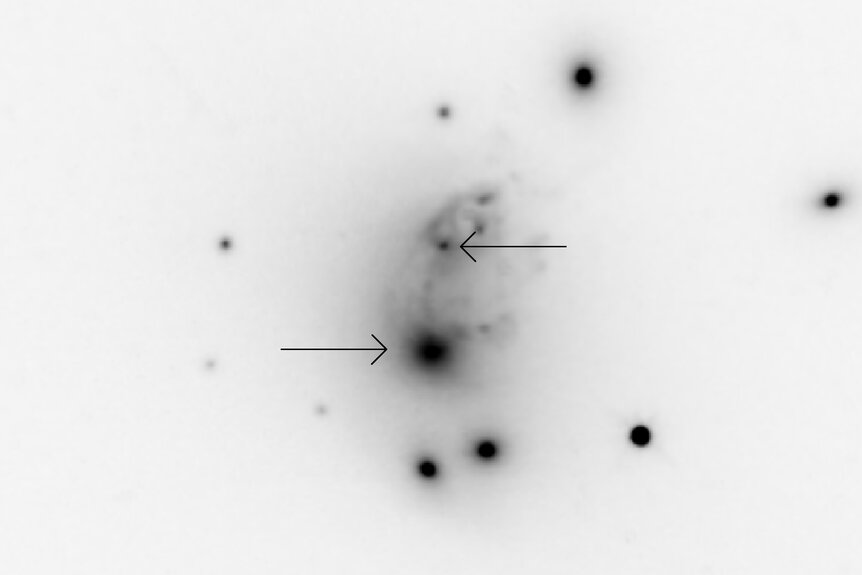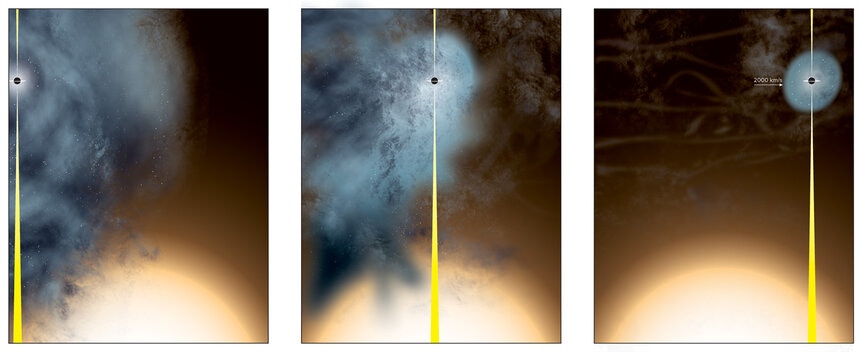Create a free profile to get unlimited access to exclusive videos, sweepstakes, and more!
How to make a nearly naked black hole
Astronomers have spotted a nearly naked black hole fleeing the scene of a close encounter, but, like a badly written romcom, a merger sometime in the future is inevitable.
So that wasn’t a first line to an article I ever really thought I’d actually write, but here we are. The Universe is a weird place.
But such an interesting one! This is actually a great science story. And like so many other great ones, it starts in a galaxy far, far away.
Galaxies are huge collections of stars, gas, dust, and dark matter held together by their own gravity. We’re pretty sure that every big one has a supermassive black hole in its exact center, one that formed with the galaxy itself and grew as the galaxy did.
Oh wait, did I say exact center? Because that may not always be the case.
Galaxies can grow by eating each other. You might think that’s rare, but it happens all the time, and in fact can be common in some environments. Lots of galaxies in the Universe live in clusters, some with hundreds or even thousands of galaxies all flying around. If two get too close each one’s gravity can grasp the other, and they might swoop past each other a couple of times before merging together to form one, bigger galaxy.
When they do this the smaller one tends to fall to the bigger one’s center. But remember, both have big black holes. Over tens or hundreds of millions of years they will come together, and like their host galaxies before them, merge.
When two ginormous black holes merge, they form a bigger black hole, but also emit a big blast of energy in the form of gravitational waves. Now when I say big, what I mean is HOLY-AIIIIEEEE-TERRIFYINGLY-RIDICULOUSLY-AIIIIEEEEEE big. So much energy is released that if the explosion is even a teensy bit off center (like if they are spinning rapidly when they eat each other) the resulting explosion acts like an impulse rocket, kicking them hard and flinging them away from the merger site at high speed, perhaps thousand of kilometers per second. Mind you, I’m talking about an object that can be millions of times more massive than the Sun, so the energy is soul-crushingly huge.
The point being that sometimes the supermassive black hole in the center of the galaxy might not be exactly in the center. It could move away from this central location after a merger (there’s also a less likely scenario where two black holes are on they way to merging when a third galaxy gets eaten, dropping its black hole down to the center; the interaction of the three monsters can fling one away as well in a cosmic version of a slingshot).
This is an interesting idea, but can it actually happen? To find out, a team of astronomers looked at a bunch of galaxies, searching for any signs of an off-kilter supermassive black hole. It’s possible to do this because after a merger, the black hole could still have enough material around it to create an accretion disk, a huge disk of swirling material that’s sort of an anteroom, a waiting area for this stuff to eventually fall into the black hole itself. But friction and other forces heat this material up enough to glow, and while we can’t see the black hole itself, the accretion disk can be pretty bright. Luminous enough to be seen for billions of light years!
So the astronomers surveyed a bunch of galaxies with a radio telescope, looking for that glow. It’s possible to use radio telescopes in a way to very precisely nail down the objects’ positions, so if one is offset from the galactic center, it would be easier to find.
And yup. They found one.
The galaxy cluster ZwCl 8193 (the 8193rd entry in the Zwicky Cluster catalog) is about 2.2 billion light years away, which is a long way. At its center is a big, bloated elliptical galaxy, which is pretty typical of clusters like this; lots of collisions have allowed it to grow large, and the energy of the mergers have made it puffy. It’s something like 300,000 light years across, three times bigger than the Milky Way (which is a pretty big galaxy in the first place).
But there’s an anomaly. Very close to the center of this galaxy, about 25,000 light years out, is a small knot of stuff that looks like a tiny galaxy, only about 3,000 light years across. It’s called B3 1715+425 (let’s call it B3 for short), and while that size is pretty small for a galaxy, but there’s a big black hole there for sure; it emits radio waves and even X-rays (very high-energy light that takes a huge power source to create) in just the way a beefy black hole does.
Not only that, but when they looked at spectra of the both B3 and the core of the bigger galaxy, they found B3 is moving away, probably faster than 2,000 kilometers per second.
That sure sounds like a galaxy collision! In this case, what most likely happened is that a smallish galaxy got et by a bigger one. The small galaxy, complete with central supermassive black hole, passed very close to the center of the bigger one in the middle of the cluster. As it did, the bigger galaxy’s gravity stripped away the majority of the smaller galaxy’s stars and gas. What we see now, after the encounter, is B3: just a mantle of material a few thousand light years across with a big ol’ black hole in the middle. There was still enough junk left to swirl around that black hole and create enough light for us to see it, but just barely.
There’s more evidence this is the case, too. A few years ago, a different team of astronomers happened to use Hubble to take some deep observations of ZwCl 8139, and in the resulting image (above) you can clearly see B3 and the core of the central galaxy. But if you look carefully you can also clearly see a line of material between the two, which is also what you expect from a close encounter. The gas that was in the smaller galaxy got stripped away, and fell behind B3 as it moved out.
Spectra also show that this gas is moving rapidly, but the gas at the end of the trail closer to the center of the big galaxy is moving more slowly than the gas at the other end, nearer B3; that’s exactly what you expect from material stripped from the smaller galaxy and slowing as it rams through the gas in the bigger galaxy. It’s like opening a window in a car when your dog (say) emits a foul odor. The wind blows that gas out. Same with galaxies, though on a decidedly bigger scale.
And oh, one more thing: As I mentioned, B3 and its black hole are moving outward from the bigger galaxy at a speed of something like 2,000 km/sec. However, judging from the data, that’s not quite fast enough to escape the gravitational clutches of the big galaxy! So eventually it will slow, turn around, and fall back in. At that time, it’s pretty likely they’ll merge for real; what’s left of B3 will get digested by the bigger galaxy, and the two black holes will dance for a while, then become one. When they do, there will be a vast blast of gravitational waves, and who knows? Maybe that’ll be enough to kick the resulting slightly-more-massive black hole away from the center, ironically what the astronomers were looking for in the first case... just a few eons too early to actually see it.
We’ve seen lots of galaxies colliding, and even smaller ones getting stripped of material, but not one like this where the galaxy sizes were just right and the encounter geometry just so, making it the first nearly naked black hole in the surviving core of a stripped galaxy ever seen.
I may have mentioned the Universe is weird. But it sure is fun to learn about.

















